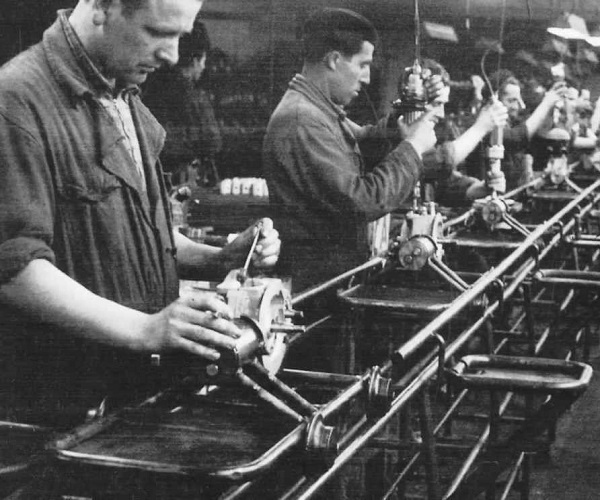History of industrial safety

Descripción
The slaves played an important role in the productive activities of the ancient world, since they were the ones who carried out the most arduous and risky tasks. We can even say that work has always been associated with slavery and physical effort.
Egypt is one of the civilizations of the ancient world that has had remarkable innovations in occupational health and safety. For example, in Egypt harnesses, sandals and scaffolding were used as safety implements. These devices were used by slaves who were dedicated to build the pyramids and sphinxes that adorned the Egyptian city.
The era of important advances for workers in Greece, took place between the sixth and fourth centuries BC. where differentiated work was developed with the construction of the Great Acropolis. The largest contributions on occupational medicine in Greece were in the field of mine work and that of poisoning diseases. The father of medicine, Hippocrates (460-370 BC) wrote a treatise on the diseases of miners, who recommended taking hygienic baths to avoid lead saturation.
384-322 a.c.
Aristotle, philosopher and Greek naturalist, also intervened in the occupational health of his time, because he studied certain physical deformations produced by occupational activities, raising the need for prevention. He also investigated diseases caused by lead poisoning.
62 -113 d.c.
In Rome, mercury toxicity was described by Plinio and Galeno, referred to the dangers of sulfur and zinc management and enunciated several preventive standards for workers in lead and mercury mines. For example, he recommended to the miners, the use of respirators manufactured with the bladder of animals.
Rome being the cradle of law and jurisprudence, in addition to the laws of conduct and protection of private property, legal measures were also taken on health as the installation of public toilets, and protection for workers.
130-200 d.c.
Another notable figure of Rome was Galen, who after Hippocrates is considered the most important physician of the ancient world in the West. Galen studied the diseases of miners, tanners and gladiators. It also mentions diseases associated with lead vapors and respiratory diseases in mine workers.
Renaissance
In France the first universities were founded in the tenth century and the first laws that protect workers also arise. It would be in the laws that the first advances towards the formalization of labor security are supported.
1413-1417
The French Ordinances that rule for the safety of the working class are ruled.
1473
In Germany, a pamphlet by Ulrich Ellenbaf is published, pointing out some occupational diseases. This would be the first printed document dealing with security and one of the first texts on occupational health.
In the Renaissance, ad portas of the modern age, two men -Agrícola and Paracelsus- describe in their works, occupational diseases and their respective systems of protection making important contributions to occupational hygiene.
Modern age
Kircher writes Mundus subterraneus where he describes some symptoms and signs of the diseases of the miners such as cough, dyspnea and cachexia.
1665: Walter Pope publishes Philosophical transactions where he refers to the diseases of miners produced by poisoning with mercury.
Ramazzini set a very important precedent in the field of occupational health, but with the nascent industry of the eighteenth century, the interest of scientists focused on the technical aspects of work first and safety later, so that occupational health would go through a latency period until the end of the 19th century.
Industrial Revolution
1500 - XVIII Century
The manual industries progressed, thanks to the creation of the crank, the water pumps, the Kay shuttle.
1736-1819
James Watt invents the steam engine, by perfecting the aforementioned artifacts and thereby initiates the process of mechanization of production systems and transport.
Labor, artisan crafts were replaced by mass production. The migrant farmers did not receive the salary they expected, but they were forced to work in subhuman conditions because they had no other option. As the number of migrants exceeded the capacity of the cities, the population density increased and as a result there was overcrowding and diseases and epidemics proliferated. Health and safety conditions were minimal, partly because of the number of workers, but mainly because of the lack of an efficient safety culture, both on the part of workers and workers, and employers. Two thirds of the workers were women and children, who in addition to being exploited were not provided with the necessary security conditions, so that many children and women suffered injuries, mutilations or died in tragic but recurrent accidents.
Due to this painful situation, laws were introduced to protect workers.
1778
In Spain Carlos III gave the edict of protection against accidents.
1802
The English Parliament gives the regulation of work in factories that limits the working day and sets minimum levels for hygiene, health and education of workers.
1828
Robert Owen launches a program for the environmental, educational and moral improvement of workers. Two years later, Robert Backer proposed that a doctor should make a daily visit to the factories.
1841
The law of work for children arises.
1844
Laws appear that protect women. In Manchester the machines operated without protection. And it was not until 1877 that orders were placed to place the machines.
Similar laws already contemplated since 1855 aspects such as the ventilation and protection of tunnels in disuse, the signaling, the use of manometers and valves suitable for steam boilers, and the requirement of indicators and brakes in the case of devices for lifting equipment.
Karl Marx (1818-1883) and Frederic Engels (1820-1895), who were interested in the rights of workers, are the promoters of unionization that would serve as a channel for the improvement of working conditions, including security.
On May 4, 1886, the Chicago Revolt took place, culminating in the fair establishment of 8 hours of work.
1848
Health legislation was initiated for the industry.
Two years later the inspections begin to verify compliance with the regulations, which would have legal support.
The first fire extinguishing system was implemented by Frederic Grinnell in 1850 in the United States.
1867
A law was enacted that named the inspectors in the factories.
1868
Workers compensation laws appear 9. Max von Pettenkofer (1818-1901) founded the first Hygiene Institute in Munich in 1875.
1874
England and France were the countries that led the formalization of occupational health and safety in Europe.
1890
The legislation that protects society and workers against occupational hazards is widespread throughout the world.
1911
The State of Wisconsin passed the first law that regulates workers compensation.
Twentieth century
Along with all the technical advances that made possible the passage to the twentieth century with the massification of electrical energy sources or thermodynamics in homes and industry, respectively; the theories and conceptions about the administration of work also put their share in the process of formalization of security that culminated in the institutionalization of industrial safety.
1918
Harvard University was the first house of higher education that granted the title of Bachelor of Safety and Hygiene at Work.
In 1918, the International Labor Organization (ILO) began to operate. Another important event was the Treaty of Versailles, which in its XII section established principles that the ILO would later take, so that in 1921 its Service and Prevention of Accidents was created.
In 1918 the American School also appears with Heinrich, Simonds, Grimaldi and Birds; which proposed an analytical and preventive approach to accidents.
The first references about damage to human hearing caused by noise are found in the Regimen Sanitatis Salerenitarum that was written in 1150.
By 1960, industrial safety is already a science and a profession, whose contributions to industry and work, are valued while eliminating or minimizing occupational risks, allowing to reduce the economic costs that affect production.
At present, industrial safety has generated great interest on the part of employers, workers and politicians. In particular, governments have invested money in the dissemination of safety standards and in the periodic inspection of companies, factories and industries through various control agencies.


